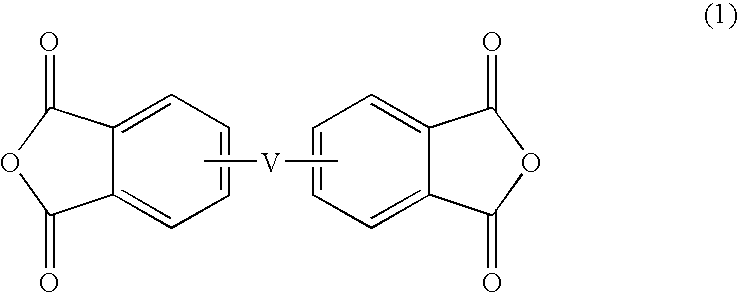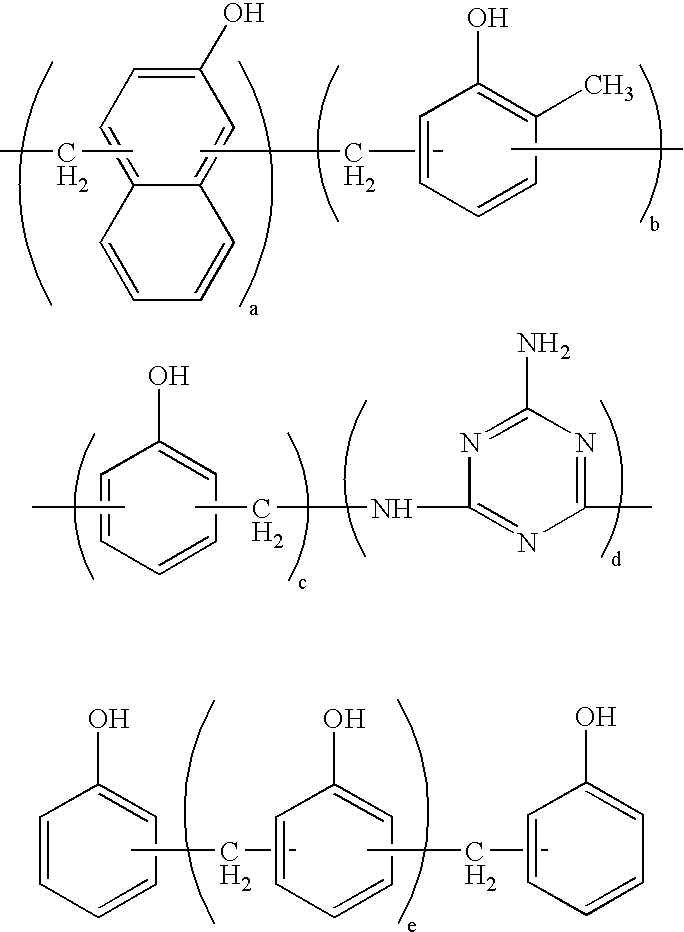Thermosetting resin composition, multilayer body using same, and circuit board
a technology of resin composition and multilayer body, applied in the direction of metal layered products, group 5/15 element organic compounds, film/foil adhesives, etc., can solve the problems of degradation of dielectric characteristics, inability to obtain satisfactory dielectric characteristics, and processability problems, and achieve excellent heat resistance, dielectric characteristics, and flame retardance. , the effect of excellent processability
- Summary
- Abstract
- Description
- Claims
- Application Information
AI Technical Summary
Benefits of technology
Problems solved by technology
Method used
Image
Examples
synthesis example 1
Polyimide Resin
[0298] Into a 2,000-mL glass flask charged with dimethylformamide (hereinafter referred to as “DMF”), 0.95 equivalents of 1,3-bis(3-aminophenoxy)benzene (hereinafter referred to as “APB”) and 0.05 equivalents of 3,3′-dihydroxy-4,4′-diaminobiphenyl (manufactured by Wakayama Seika Kogyo Co., Ltd.) were added and dissolved under stirring in a nitrogen atmosphere to prepare a DMF solution. Subsequently, after the flask was purged with nitrogen, the DMF solution was cooled in an ice bath under stirring, and 1 equivalent of 4,4′-(4,4′-isopropylidenediphenoxy)bisphthalic anhydride (hereinafter referred to as “IPBP”) was added thereto. The resulting mixture was stirred further for 3 hours to obtain a polyamic acid solution. The amount of the DMF used was set so that the charge ratio of APB, 3,3′-dihydroxy-4,4′-diaminobiphenyl, and IPBP monomers was 30% by weight.
[0299] The polyamic acid solution in an amount of 300 g was transferred to a vat coated with a fluororesin, reduc...
synthesis example 2
Synthesis of Phosphazene Compound as Starting Material
[0300] Into a 5-L flask equipped with a reflux condenser, a thermometer, an agitator, a phosphorus trichloride dropping funnel, and a chlorine gas blowing tube, 2.5 L of chlorobenzene, 182.5 g (3.4 mol) of ammonium chloride, and 2.5 g of zinc chloride were charged to prepare a mixed dispersion liquid. The dispersion liquid was heated to 130° C., and 425.5 g of phosphorus trichloride was dripped under refluxing at a rate of 9 g / min over 48 minutes. At the same time, 227 g of chlorine gas was fed at a rate of 5 g / min over 46 minutes. After phosphorus trichloride and chlorine gas were fed, reflux (131° C.) was further performed for 150 minutes to complete the reaction. Subsequently, unreacted ammonium chloride was removed by suction filtration. The filtrate was subjected to a reduced pressure of 1.0 to 3.0 hPa, and chlorobenzene was distilled off at 30° C. to 50° C. Thereby, 352 g of a reaction product was obtained. The yield of th...
synthesis example 3
Synthesis of Phenoxyphosphazene Compound (D-1)]
[0307] Into a 2-L four-necked flask equipped with a reflux condenser, a thermometer, an agitator, and a dropping funnel, 58 g (0.5 unit mol, NPC12 being one unit) of hexachlorocyclotriphosphazene with a purity of 99.9% and 100 mL of THF were charged to prepare a solution. Subsequently, a separately prepared THF solution of Na salt of 4-methoxyphenol (4-methoxyphenol 68.3 g (0.55 mol), sodium 11.1 g (0.44 g-atom), and THF 200 mL) was added dropwise to the THF solution of hexachlorocyclotriphosphazene over one hour under stirring. Since the reaction was highly exothermic, the reaction was allowed to proceed while properly cooling so that the reaction temperature did not exceed 30° C. After dropping was completed, stirring was continued for 6 hours at 60° C. The residual chlorine content in the partially substituted compound obtained by this reaction was 15.78%, and the estimated structure was N3P3Cl3.36(OC6H4OCH3)2.63.
[0308] Subsequently...
PUM
| Property | Measurement | Unit |
|---|---|---|
| Temperature | aaaaa | aaaaa |
| Fraction | aaaaa | aaaaa |
| Fraction | aaaaa | aaaaa |
Abstract
Description
Claims
Application Information
 Login to View More
Login to View More - R&D
- Intellectual Property
- Life Sciences
- Materials
- Tech Scout
- Unparalleled Data Quality
- Higher Quality Content
- 60% Fewer Hallucinations
Browse by: Latest US Patents, China's latest patents, Technical Efficacy Thesaurus, Application Domain, Technology Topic, Popular Technical Reports.
© 2025 PatSnap. All rights reserved.Legal|Privacy policy|Modern Slavery Act Transparency Statement|Sitemap|About US| Contact US: help@patsnap.com



